Reported distribution of road traffic deaths by type of road user by country
Estimated number of road traffic deaths
The High Toll of Traffic Injuries: Unacceptable and Preventable
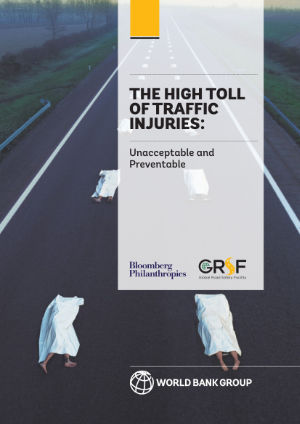
Each year, 1.25 million people lose their lives on the world’s roads and another 20 to 50 million are seriously injured. The tragic loss from a road traffic death or serious injury is compounded by the harm to households and social networks. A disproportionate 90% of road traffic injuries (RTIs) occur in low- and middle-income countries (LMICs), representing a major public health and economic burden. This is an eminently preventable problem that is critical to the development agenda. Unfortunately, due to lack of solid data, the impact of road injuries on economic growth and social welfare has been difficult to assess.
A new World Bank report funded by Bloomberg Philanthropies, The High Toll of Traffic Injuries: Unacceptable and Preventable, looks to fill the gap. It proposes a comprehensive methodology to quantify both the income growth and social welfare benefits that safer roads could bring to developing countries. The analysis is based on data collected from 135 countries over 24 years, and focuses on China, India, the Philippines, Tanzania, and Thailand—five geographically, demographically and economically diverse LMICs.
The study shows that reducing the number of RTIs in developing countries not only increases income growth, but also generates substantial welfare benefits to societies.
Key findings from the report include:
- Reducing the number of RTIs leads to long-term national income growth. This correlation is easy to establish as RTIs are the single largest cause of mortality and long-term disability among young people aged 15-29 (prime working age).
- Significant long-term income growth—7 to 22% increase in GDP per capita over 24 years—can be achieved by halving road traffic deaths and injuries, in line with the current UN targets.
- The study goes beyond productivity or economic gains, and highlights the broader welfare benefits associated with reducing road traffic mortality and morbidity, adding years of life free of injuries and lasting disabilities. This recognizes that GDP is an imperfect measure of social welfare, as it does not factor health benefits. The study finds welfare benefits equivalent to 6 to 32% of the national GDP can be realized from reducing road deaths and injuries by 50% over 24 years.
- By maximizing healthy years of life, free of injuries and disabilities, actions to reduce road traffic injuries can help countries increase productivity, enhance the well-being of their populations, and build human capital—a key developmental priority for the World Bank.
- Road safety goes beyond the transport sector, with a direct impact on public health, societies, and economies. Likewise, because road safety is an inherently cross-sectoral issue, real progress can only happen if all relevant stakeholders unite their efforts.
Country Guidelines for the Conduct of Road Safety Management Capacity Reviews and the Specification of Lead Agency Reforms, Investment Strategies and Safe System Projects
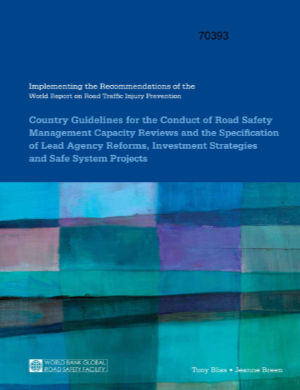
The World Health Organization (WHO) and the World Bank jointly issued the World Report on Road Traffic Injury Prevention on World Health Day 2004, dedicated by the WHO to the improvement of global road safety. The report’s publication signaled a growing concern in the global community about the scale of the health losses associated with escalating motorization and a recognition that urgent measures had to be taken to sustainably reduce their economic and social costs. Implementing the report’s recommendations has become a high priority for low and middle-income countries and the guidelines presented in this report have been prepared to assist this task.
The guidelines promote a Safe System approach to road safety and specify a management and investment framework to support the successful implementation of the World Report recommendations. They include practical procedures designed to accelerate knowledge transfer and sustainably scale up country investment to improve road safety results. They set out detailed steps for the conduct of country road safety management capacity reviews and the related specification of lead agency reforms, investment strategies and Safe System projects designed to overcome revealed safety management capacity weaknesses.
The guidelines have been prepared to assist country road safety professionals, World Bank and regional development bank staff, international consultants, community groups, private sector organizations, and all other global, regional and country partners and stakeholders undertaking country road safety investments.
Strategies to Tackle the Issue of Speed for Road Safety in the Asia-Pacific Region: Implementation Framework
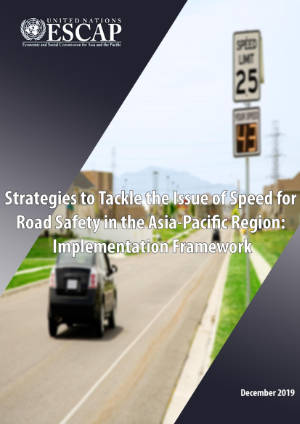
As has been underscored at a number of key global events and in numerous documents published over the last decade, improving road safety is now an urgent global priority. The unfortunate reality is that road safety programmes and policies have failed to address the increase in the number of vehicles on roads and the average speed at which vehicles are travelling. This has exacerbated an already grave global road safety crisis.
The laws of physics relating to speed mean that all countries and regions would benefit from reductions in average vehicular speeds. Indeed, there is a direct correlation between vehicular speeds and the likelihood of people suffering physical harm, with the probability of crashes, injury and death rising as the speed of vehicles increases. Furthermore, vulnerable road users, including pedestrians, cyclists and motorcyclists, are all at high risk of severe or fatal injury in crashes, even at low speeds, because they are poorly protected. The harmful effects of speed also increase on wet, snowy or icy roads. However, any action taken to reduce vehicular speeds helps to reduce the number of crashes, injuries and fatalities, regardless of weather conditions and among all categories of road user.
Ideal speeds are lower than most road users think. Lower vehicular speeds are more economical than high speeds, and can enhance people’s environment, health and quality of life as a result of a reduction in costs associated with crashes, road maintenance, noise, fuel use, and emissions. There is also a turning point at which traffic flow improves with lower speeds.
A safe speed is one that is appropriate not only for the usage/type and quality of the road but also for a country’s vehicular fleet and the type and mix of the road users. The management of vehicular speed therefore includes setting speed limits that reflect those considerations and reduce the likelihood of death or injury in the event of a crash (these are known as survivable speed limits) as well as preventing speed limit violations (speeding).
For this report, a study was conducted to examine speed management in ESCAP member States in order to identify ways in which they can improve speed management. The study revealed that travel speeds on roads in those States are not controlled effectively through survivable speed limits, speeding enforcement, engineering interventions or vehicle safety measures.
Road Safety in the Asia-Pacific Region
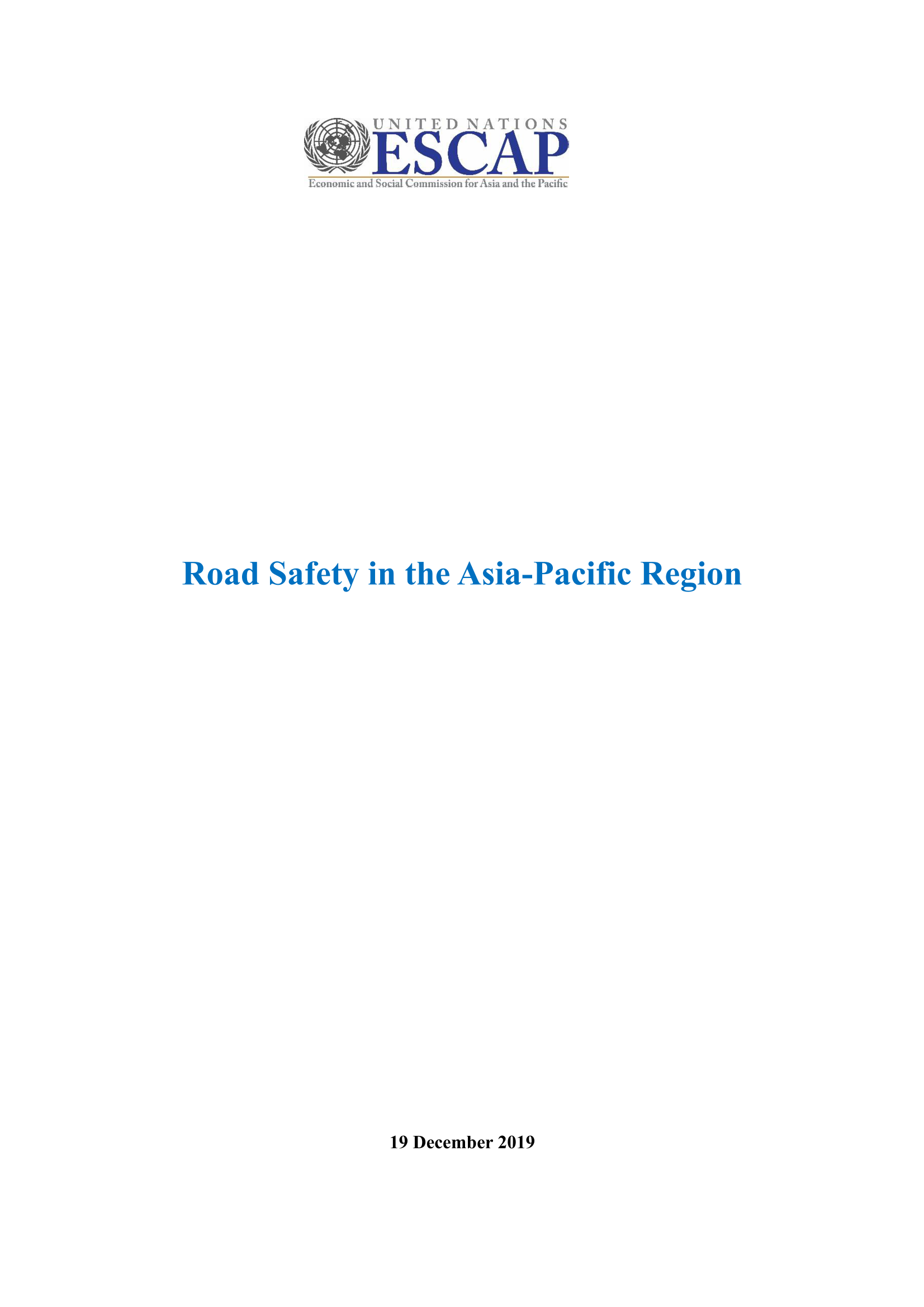
Road safety is a sustainable development challenge for the whole world. The global road traffic deaths and rates of road traffic death remain unacceptably high as an estimated 1.35 million road traffic deaths occurred in 2016 which was about 3,700 road traffic deaths a day.1 Globally, road crashes are the 8th leading cause of death for people of all ages and number one cause of death for children and young adults 5-29 years of age. However, the rates of road traffic death remained constant since the beginning of the millennium, which was about 18 road traffic deaths per 100,000 population.
This report summarizes the analyses of the road safety data from the ESCAP member countries fall under the road safety management pillar of the UN Decade of Action for Road Safety (2011- 2020). This study considered analyzed data involving different pillars and areas of the The United Nations Global Framewor Plan of Action 2018. The pillars and areas under the framewor are shown in Figure 5 of the Appendix 2 of this report.
Updated Estimates of the Relationship Between the Business Cycle and Traffic Fatalities
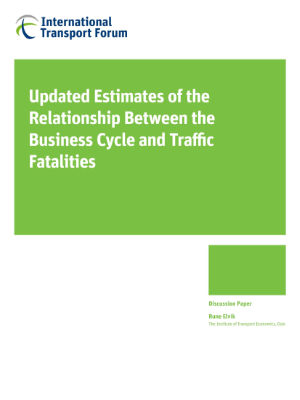
This paper updates analyses of the relationship between fluctuations of the business cycle and the number of traffic fatalities published in 2015 by the International Transport Forum. Since then, the global recession that started in 2008 has ended and economic growth has returned to most International Transport Forum countries. The paper revisits the affect that declining or stable high rates of unemployment have on traffic fatalities.
Safer City Streets: Global Benchmarking for Urban Road Safety
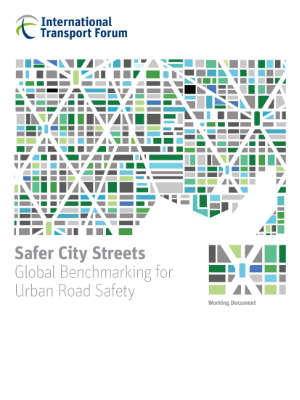
This document aims to support cities in setting road safety targets and to monitor progress in improving urban road safety. Pedestrians, cyclists and motorcyclists account for nearly 80% of urban traffic fatalities. Cities should thus intensify efforts to improve the safety of vulnerable road users. This document presents traffic safety indicators for different road user groups collected in 31 cities to facilitate the evaluation, monitoring and benchmarking of road safety outcomes. It places a particular attention on measuring the risk of fatality per unit distance travelled.
Safe Micromobility

This report examines the safety aspects associated with the increasing use of e-scooters and other forms of micromobility in cities. The rise of micromobility challenges existing regulations for urban traffic and forces policy makers to rethink them. The report considers a range of actions to make urban traffic with micromobility safe, including in street layout, vehicle design and vehicle operation, user education and enforcement of rules. It also asks whether a shift towards micromobility can have potential safety benefits.
New Directions for Data-Driven Transport Safety
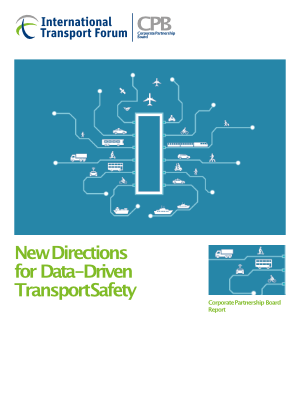
This report explores how seamless data collection, analysis and sharing can unlock innovations in transport safety. Most interventions to improve transport safety are reactions to incidents. Connected vehicles, smartphone apps, ubiquitous sensors, data sharing and machine learning make proactive transport safety interventions possible and prevent crashes before they happen. Drawing on the Safe System approach, this report examines how transport stakeholders can make better decisions by using more relevant and timely data.
Pagination
- Previous page
- Page 2
- Next page